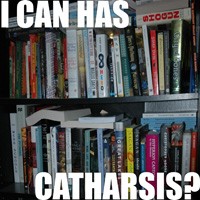I’ll let you into a little secret of mine, which is this: I’m the sort of dude that gets wrung out about emotional scenes in books and movies and TV. I date this tendency back to a specific event, which was the birth of my daughter. Before then, I could read or watch a scene of complete heartbreak and go “eh”; after her birth, I get choked up watching very special episodes of SpongeBob SquarePants. I hate it, man. Among the reasons I hate it is that when I go out in public to do a reading, there are entire books of mine that I can’t read aloud, because I can’t get through them without sobbing. And, you know, look: When you can’t get through something you’ve read a hundred times because you actually wrote it without turning into a blubbering fool, there’s something wrong with you.
That said, I’ve often wondered if one entertainment medium is better at wrenching emotions out of people than others. Apparently so had scientists Mbemba Jabbi, Jojanneke Bastiaansen and Christian Keysers, so they set out to discover whether visual and written mediums had any difference in how they were able to evoke emotional responses (specifically, the emotion of disgust).
Their results, published in a paper with sales-grabbing title “A Common Anterior Insula Representation of Disgust Observation, Experience and Imagination Shows Divergent Functional Connectivity Pathways,” show that both affect us powerfully, because both written and visual representations affect the same parts of the brain:
“We placed our participants in an fMRI scanner to measure their brain activity while we first showed our subject short 3s movie clips of an actor sipping from a cup and then looking disgusted,” said Christian Keysers. “Later on, we asked them to read and imagine short emotional scenarios; for instance, walking along a street, bumping into a reeking, drunken man, who then starts to retch, and realizing that some of his vomit had ended up in your own mouth. Finally, we measured their brain activity while the participants tasted unpleasant solutions in the scanner.”
“Our striking result,” said Keysers, “is that in all three cases, the same location of the anterior insula lit up. The anterior insula is the part of the brain that is the heart of our feeling of disgust…What this means is that whether we see a movie or read a story, the same thing happens: we activate our bodily representations of what it feels like to be disgusted—and that is why reading a book and viewing a movie can both make us feel as if we literally feel what the protagonist is going through.”
In a way, this is a relief for me. Although I am a writer, some part of my brain felt like I should be able to hold myself together a little better reading a book than watching a movie (particularly, you know, if it’s my book). Now that I know it’s all working on the same part of the brain, I’ll feel more free to blubber with abandon. I mean, even more than I already do. And in a writerly sense, it’s good to know that my favorite medium doesn’t suffer any disadvantage when it comes to visceral impact. Because, you know. It’s not enough that I blubber uncontrollably when I read my work. I really want to make you blubber uncontrollably, too. I think some of you may have already figured out that part.










